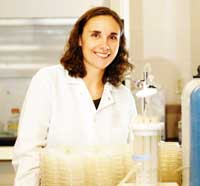Aug 24 2008
Montana State University scientist Darla Goeres knows that there is more than one way to grow a biofilm, a fact that she uses to make sure that when a product claims it kills "99 percent" of bacteria, it really does the job.
 Biofilms researcher Darla Goeres poses in her lab at MSU's Center for Biofilm Engineering. Credit: MSU photo by Kelly Gorham
Biofilms researcher Darla Goeres poses in her lab at MSU's Center for Biofilm Engineering. Credit: MSU photo by Kelly Gorham
Biofilms are the extremely common communities of bacteria that form on most wet surfaces. They range from the plaque on teeth to the slime on streamside rocks to the sludge that clogs pipes.
Most biofilms are harmless, but some have been linked to ailments such as urinary tract infections, gingivitis and infections around implanted devices like artificial joints and heart valves.
"In the world that I study, everybody's trying to kill the biofilm," said Goeres, a research professor in the Department of Chemical and Biological Engineering. "But there's not a concrete answer for that, and that's why you need to understand methods."
Earlier this year, Goeres was awarded a five-year, $1.7 million contract from the Environmental Protection Agency to work on new ways to measure how well antimicrobial products perform against biofilms.
"The EPA contract provides a solid basis of support," Goeres said. "That's why we can be one of the few labs in the world that can focus on methods development."
Goeres works in the Standardized Biofilms Methods Laboratory at MSU's Center for Biofilm Engineering. There, she develops standards for growing, treating and sampling biofilms.
All biofilms are unique. They are composed of varying numbers of different bacteria, and the conditions under which these bacteria form a biofilm can make a big difference in the resulting slime. So a product designed to kill one biofilm might not work on any others, which makes proving the effectiveness of antibacterial cleaning products tricky.
"Every time a person buys a product with an EPA-approved efficacy claim, such as 'kills 99 percent of bacteria,' the public trusts the validity of the process used to prove that claim," Goeres said.
However, the method a company uses to prove its product's effectiveness can make a big difference in the test results. Until recently, most methods for testing products involved growing bacteria in a way that's not consistent with the real world, Goeres said.
"Our goal is to grow bacteria in a way that's relevant to how the bacteria exist where the product is used," she said. "That way, we can have more confidence in the product's actual effectiveness, and so can the public."
The EPA contract will allow Goeres to hire two additional undergraduate students for her lab, where they will receive training and experience that will help them continue into graduate school or biofilms jobs. The lab normally hires four to six undergraduates each year.
Goeres said her biofilm methods work, which can seem detached from the real world, is ultimately about making sure people can trust the products they're using to keep their homes clean.
"So many results depend on the process a person uses," Goeres said. "To have only one way to grow a biofilm isn't going to cut it."